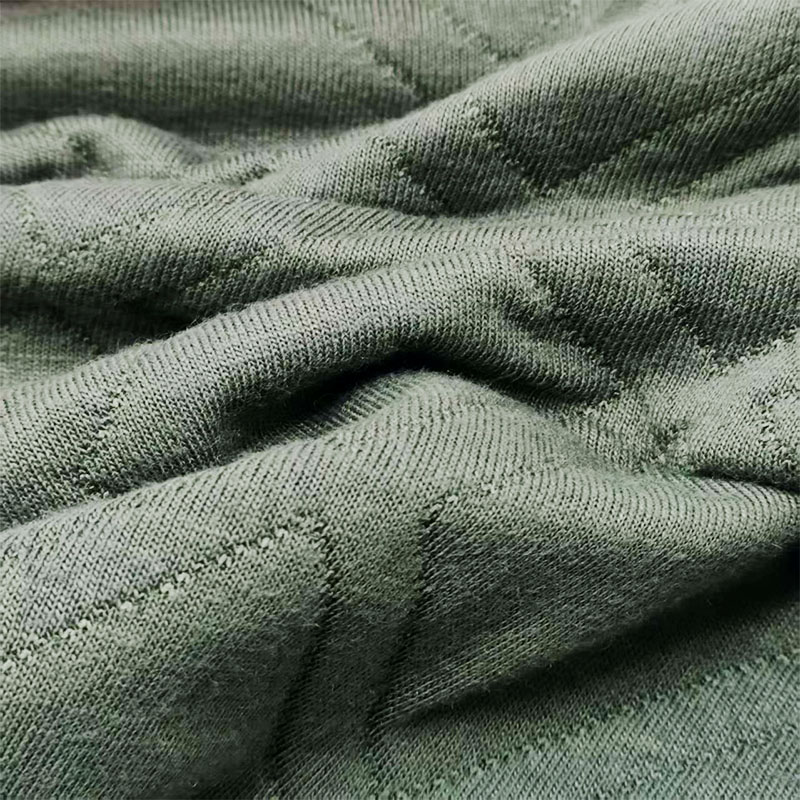When it comes to loungewear and underwear—categories where comfort, stretch, and durability directly impact customer loyalty—brands face a critical choice: polyester spandex fabric or cotton spandex? For global underwear and loungewear brands (especially those targeting markets like North America, Europe, or Southeast Asia), this decision isn’t just about fabric feel—it also ties to supply chain efficiency, cost-effectiveness, and meeting regional consumer expectations. Let’s break down the key differences, so you can make an informed choice for your next bulk order.
1. Stretch Recovery: Why Polyester Spandex Outperforms for Daily Wear
Both fabrics offer stretch, but polyester spandex fabric stands out for its superior elastic recovery—a non-negotiable feature for loungewear (think: oversized joggers that don’t bag at the knees) and underwear (briefs or bralettes that stay in place all day). Cotton spandex, while soft, tends to lose its shape over time: after 10–15 washes, you may notice sagging waistbands or stretched-out hems, forcing customers to replace items sooner.
For brands (foreign trade brands) focused on building long-term customer trust, this durability gap matters. Polyester spandex retains its stretch and structure even after 50+ washes—a selling point you can highlight in your product descriptions to justify higher price points. Additionally, its resistance to “stretch fatigue” makes it ideal for high-wear items, like everyday underwear or loungewear sets that customers reach for daily.
2. Moisture Management: A Game-Changer for Warm Climates (and Active Loungewear)
Post-pandemic, loungewear has evolved beyond “at-home only”—many consumers now wear it for errands, casual outings, or light workouts (think: “athleisure loungewear”). This shift makes moisture-wicking a top priority.
Polyester spandex fabric is inherently hydrophobic (water-repellent), meaning it pulls sweat away from the skin and dries quickly. For brands targeting markets like Florida, Australia, or Southeast Asia—where high humidity is a year-round issue—this prevents the “sticky, clammy” feeling that cotton spandex often causes (cotton absorbs moisture and stays damp longer).
Cotton spandex, while breathable, struggles with moisture control: in warm weather, it can leave wearers feeling uncomfortable, which leads to negative reviews and lower repeat purchases. For brands selling to these regions, polyester spandex isn’t just a fabric choice—it’s a way to align with local climate needs.
3. Supply Chain & Cost: Polyester Spandex Fits Bulk Orders
For loungewear and underwear brands that rely on bulk production (a common need for clients), polyester spandex offers clear advantages over cotton spandex:
Stable pricing: Unlike cotton (which is subject to global market fluctuations—e.g., droughts or trade tariffs that spike costs), polyester is a synthetic material with more predictable pricing. This helps you lock in budgets for large orders (5,000+ yards) without unexpected expenses.
Faster lead times: Polyester spandex production is less dependent on agricultural cycles (unlike cotton, which has planting/harvest seasons). Our factory typically fulfills bulk polyester spandex orders in 10–14 days, compared to 2–3 weeks for cotton spandex—critical for brands that need to meet tight retail deadlines (e.g., holiday seasons or back-to-school launches).
Low maintenance in transit: Polyester spandex is wrinkle-resistant and less prone to damage during long shipping (e.g., ocean freight from China to the US). This reduces waste from “damaged goods” and cuts down on pre-retail preparation (no need for extensive ironing before packaging).
4. Softness & Sustainability: Addressing Consumer Concerns
We hear the pushback: “Cotton spandex is softer, and customers want natural fabrics.” But modern polyester spandex has closed the softness gap—our premium blend uses 40s count polyester yarns that feel as soft as cotton, with none of the “plastic-like” texture of low-quality polyester.
For brands prioritizing sustainability (a must for European markets like Germany or France), our recycled polyester spandex option uses 85% post-consumer plastic bottles and meets OEKO-TEX® Standard 100. This lets you market “eco-friendly loungewear/underwear” without sacrificing performance—while avoiding the higher cost of organic cotton spandex (which can be 30% more expensive).
Final Verdict: Polyester Spandex for Scalable, Customer-Centric Brands
If your loungewear/underwear brand focuses on durability, global scalability, and climate-specific comfort (e.g., warm regions or active wear), polyester spandex fabric is the better choice. It solves the pain points that cotton spandex can’t—like shape retention, moisture management, and predictable bulk ordering—while still meeting consumer demands for softness and sustainability.
Post time: Aug-28-2025


